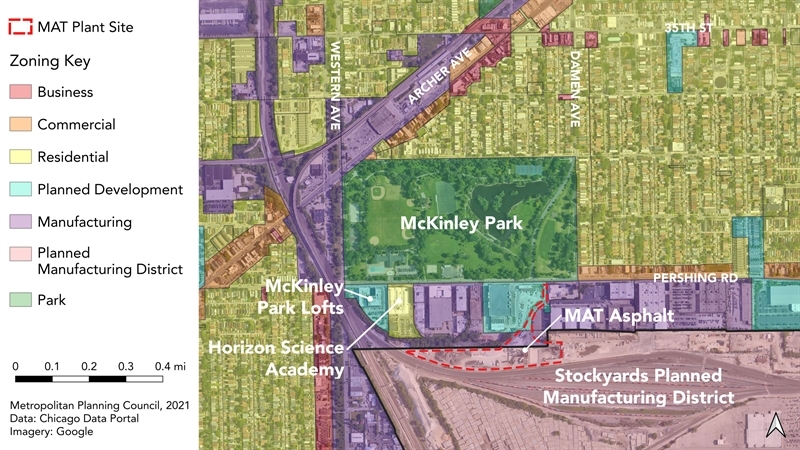Yesterday’s Zoning: Next to a Park and Schools, an Asphalt Plant

This is the second part in a series about yesterday’s policies, today’s challenges, and tomorrow’s opportunities. Read part one here.
The grassy lawns, sports fields, and lagoon of McKinley Park are frequented by families and students of Horizon Science Academy, a K-10 charter school adjacent to the park. Also adjacent to the park, trucks and other equipment rumble, busy with the production of noxious asphalt.
How did we get here? Here’s the story of how an industrial polluter arose unannounced.
A surprise construction permit and little opportunity for public input
In 2018, residents and community organization leaders of McKinley Park were surprised to learn that an asphalt plant would be moving into their neighborhood. Residents had also not been informed that this development, MAT Asphalt, had received a permit which allowed operation to commence and asphalt production to take place for up to one year after construction without applying for long-term pollution permits from the Illinois Environmental Protection Agency (IEPA).
A polluter next to a park. Poorly defined environmental rules and outdated zoning codes allowed an industrial landowner to move into a residential and recreational area with no meaningful public input.
Miscommunication and missed opportunities
Per the IEPA’s own stated policies, environmental justice areas1 should receive advance notice of developments that could exacerbate the disparities in public health impacts in those areas. McKinley Park—along with a majority of Chicago’s South and West Sides—is designated as an environmental justice area. The IEPA claims to have notified elected officials by mail of MAT Asphalt’s permit application, but State Rep. Theresa Mah and State Senator Antonio Munoz say they never received notification. Alderman George Cardenas’ office acknowledged receiving the letter but failed to announce the plant’s intentions to constituents.
IEPA policy for pollution permits also includes a 90-day window for public comment, where residents and community organizations can provide feedback that could influence stipulations in the permit. According to communication acquired from a Freedom of Information Request, that public comment window was shortened due to ‘staff oversight’. Ultimately, after MAT Asphalt agreed to a 14-day outreach period the IEPA received no public response. According to a statement to the Chicago Tribune from the IEPA’s Environmental Justice Officer, Chris Pressnal, public notification is a policy, but not a requirement by law. The policy of advanced notice to at-risk communities may seem equitable, but the lack of a system to enforce that policy allowed the IEPA to act at its own discretion in granting MAT Asphalt a one-year construction permit without input from ample accommodations for community members.

Justin Bologna, MPC 2021
MAT Asphalt Land Use and Zoning Map
Outdated zoning fails to adapt to changing land uses
Despite the disregard for a robust community-input process, the fact remains that the MAT Asphalt plant is on a parcel zoned for industrial use within a planned manufacturing district. This zoning dates back to the area’s history as a meatpacking district and home of the Union Stockyards. The Manufacturing District borders McKinley Park and provides access to rail yards and the South Branch of the Chicago River, but many of the former warehouses sit vacant. While McKinley Park was dominated by meatpacking during the first half of the 20th Century, it has since seen more diverse land uses, including areas that are largely residential. Despite these changes in land use over time, the zoning code has remained unchanged, allowing for industrial users and polluters to be located as-of-right, putting community members at risk. Antiquated zoning regulations allow for a community park, a charter school, residences, and an asphalt plant to occupy the same block.
Ongoing conflict and new pushback
Complaint data from the Chicago Department of Public Health shows that residents have filed over 130 pollution complaints since the plant opened in 2018. MAT argues that many of those complaints are unfounded and have occurred when production was not occurring. Residents have also complained of headaches, nausea, noxious smells, and dust from uncovered trucks coating their yards.
Residents have filed over 130 pollution complaints since the plant opened in 2018
In May of 2021 the Chicago City Council voted to approve a 120-unit affordable housing development close to MAT Asphalt, against the recommendation of the Chicago Department of Housing. Additional housing next to a known polluter? Yes. Outdated zoning codes recently facilitated pollution a stone’s throw from people’s homes, and now those same outdated policies—left unchecked—will endanger the health of more people and livability of more residences.
An exchange of letters between Illinois State Senators and the EPA in July of 2021 may signal that the ongoing permitting process for MAT Asphalt, who is seeking a permanent pollution permit, will undergo additional scrutiny at the behest of community members. Acting head of the EPA Cheryl Newton wrote in a letter to State Senator Dick Durbin: “[the] EPA is working closely with the state agency to ensure that this facility’s operating permit includes all applicable requirements and that public concerns — including concerns about health impacts and environmental justice — are adequately evaluated and addressed.” Newton also noted that the EPA is working closely with state regulators to ensure that MAT Asphalt complies with agency pollution standards and has completed additional air quality testing at the site in recent months.
Breakdowns in communication and a lack of accountability allowed an industrial polluter to locate in McKinley Park with no input from residents and community organizations. In giving themselves the policy-not-mandate loophole, the IEPA Environmental Justice Office allows development to go unchecked in Chicago’s at-risk communities. The MAT Asphalt plant also demonstrates how developers and landowners benefit from Chicago’s relaxed and outdated development regulations and procedures, and how the lack of comprehensive zoning code updates that include considerations for equity sustainability and public health continue to fall short of balancing the needs of industrial land users and community residents.
The MAT Asphalt plant also demonstrates how developers and landowners benefit from Chicago’s relaxed and outdated development regulations and procedures.
Stay tuned for part three as MPC takes a deeper dive into the flaws of industrial land development in Chicago. We will review lessons that can be learned, how those lessons can be applied to the new citywide planning process, We Will Chicago, and demonstrate opportunities for equitable, responsive dialogue between developers, communities, and the City of Chicago to prosper.
1 Defined as a census block group or areas within one mile of a census block group with income below poverty and/or minority population greater than twice the statewide average.
—
A previous version of this post showed an incorect boundary for the MAT Asphalt plant on the Zoning and Land Use Map. Based on reader input, this error has been corrected as of August 27. The proper boundary is now shown to the best of our knowledge.
